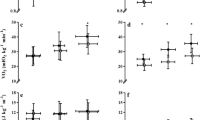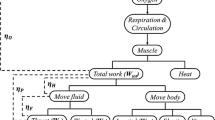Abstract
In male elite swimmers \(\dot V_{{\text{O}}_{\text{2}} } \) at a given velocity in freestyle and backstroke was on average 1 to 2 l x min−1 lower as compared with breaststroke and butterfly. Except for breaststroke, swimming with arm strokes only demanded a lower \(\dot V_{{\text{O}}_{\text{2}} } \) at a given submaximal velocity than the whole stroke. In freestyle and backstroke the submaximal \(\dot V_{{\text{O}}_{\text{2}} } \) of leg kick at a given velocity was clearly higher than the whole stroke. The highest velocity during maximal swimming was always attained with the whole stroke, and the lowest with the leg kick, except for breast stroke, where the leg kick was most powerful. At a given submaximal \(\dot V_{{\text{O}}_{\text{2}} } \), heart rate and \(\dot V_{\text{E}} :\dot V_{{\text{O}}_{\text{2}} } \) tended to be higher during swimming with arm strokes only as compared with the whole stroke. Highest values for \(\dot V_{{\text{O}}_{\text{2}} } \), heart rate and blood lactate during maximal exercise were almost always attained when swimming the whole stroke, and lowest when swimming with arm strokes only. At higher velocities body drag was 0.5 to 0.9 kp lower when arms or legs were supported by a cork plate as compared with body drag without support.
Similar content being viewed by others
References
Adrian, M. J., Singh, M., Karpovich, P. V.: Energy cost of leg kick, arm stroke, and the whole crawl stroke. J. appl. Physiol. 21 (6), 1763–1766 (1966)
Alley, L. E.: An analysis of water resistance and propulsion in swimming the crawl stroke. Res. Quart. 23, 257–270 (1952)
Åstrand, P.-0., Englesson, S.: A swimming flume. J. appl. Physiol. 33 (4), 514 (1972)
Åstrand, P.-0., Engström, L., Eriksson, B., Karlberg, P., Nylander, I., Saltin, B., Thorén, C: Girl swimmers. Acta paediat. (Uppsala) Suppl. 147, 43–63 (1963)
Dixon, R. W., Faulkner, J. A.: Cardiac outputs during maximum effort running and swimming. J. appl. Physiol. 30 (5), 653–656 (1971)
Frederiksen, R.: Om svømningens fysiologi. T. Legemsøvelser 10, 49–54 (1945)
Goodwin, A. B., Cumming, G. R.: Radio telemetry of the electrocardiogram, fitness tests, and oxygen uptake of water polo players. Canad. med. Ass. J. 27, 402–406 (1966)
Hemmingsen, I.: Energiomsaettningen under svømning hos maend og kvinder. T. Legemsøvelser 22, 53–62 (1957)
Holmér, I.: Oxygen uptake during swimming in man. J. appl. Physiol. 33 (4), 502–509 (1972)
Holmér, I.: Physiology of swimming man. Acta physiol. scand. Suppl. 407 (1974)
Holmér, I.: Propulsive efficiency of breaststroke and freestyle swimming. Europ. J. appl. Physiol. 33, 95–103 (1974)
Holmér, I., Åstrand, P.-O.: Swimming training and maximal oxygen uptake. J. appl. Physiol. 33 (4) 510–513 (1972)
Holmér, I., Lundin, A., Eriksson, B. O.: Maximal oxygen uptake during swimming and running by elite swimmers. J. appl. Physiol. (in press, 1974)
Karpovich, P. V., Millman, N.: Energy expenditure in swimming. Amer. J. Physiol. 142, 140–144 (1944)
Klissouras, V.: Energy metabolism in swimming the dolphin stroke. Int. Z. angew. Physiol. 25, 142–150 (1968)
Magel, J. R.: Propelling force measured during tethered swimming in the four competitive swimming styles. Res. Quart. 41, 68–74 (1970)
Magel, J. R., Faulkner, J. A.: Maximum oxygen uptake of college swimmers. J. appl. Physiol. 22 (5), 929–938 (1967)
Nadel, E. R., Holmér, I., Bergh, U., Åstrand, P.-O., Stolwijk, J. A. J.: Energy exchanges of swimming man. J. appl. Physiol. 36, 465–471 (1974)
di Prampero, P. E., Pendergast, D. R., Wilson, D. W., Rennie, D. W.: Energetics of swimming in man. J. appl. Physiol. (in press, 1974)
Rennie, D. W., di Prampero, P., Wilson, D. R., Pendergast, D. R.: Energetics of swimming the crawl stroke. Fed. Proc. 32 (3), 1125 Abs. (1973)
Stenberg, J., Åstrand, P.-O., Ekblom, B., Royce, J., Saltin, B.: Hemodynamic response to work with different muscle groups, sitting and supine. J. appl. Physiol. 22 (1), 61–70 (1967)
Ström, G.: The influence of anoxia on lactate utilization in man after prolonged muscular work. Acta physiol. scand. 17, 330–451 (1949)
Author information
Authors and Affiliations
Rights and permissions
About this article
Cite this article
Holmér, I. Energy cost of arm stroke, leg kick, and the whole stroke in competitive swimming styles. Europ. J. Appl. Physiol. 33, 105–118 (1974). https://doi.org/10.1007/BF00449512
Received:
Issue Date:
DOI: https://doi.org/10.1007/BF00449512




